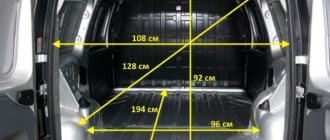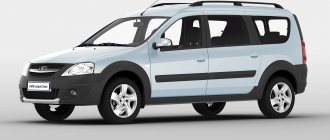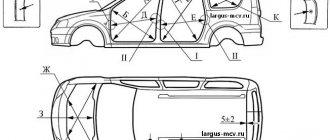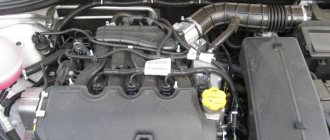Features of the Largus Van model
Although this utility vehicle is produced at the AvtoVAZ enterprise and is endowed with Lada emblems, it was developed jointly with the Renault concern, in a sense it can also be considered a French (Romanian) brand. Since 2012, the model has been produced without restyling and any global modernization, unless you take into account the changed range of engines and the appearance of a modification with gas equipment (LPG).
The Largus Van is equipped with only one row of seats and has an impressive cargo compartment with three doors (two side doors and a rear double door), which ensures convenient loading and unloading of transported goods or things. There is a removable partition between the passenger cabin and the cargo compartment; there are no side trims inside the van (only painted metal).
The rear swing doors of the body can be fixed in three positions - at opening angles of 40, 90 and 180 degrees , the side doors here open wide. In all configurations, except the simplest one, a polyethylene floor mat is provided in the cargo compartment; the van also has a backlight and six mounting loops for securing luggage. The cargo compartment is characterized by a flat floor, no thresholds, and a fairly low and therefore comfortable loading height.
Increasing the volume of the cargo compartment (removing the excess part on the floor)
The cargo compartment volume of the Lada Largus van can be increased. To do this, remove the floor covering.
There are two types of fasteners here
We will need special Torx keys, without which the screws cannot be unscrewed: Torx T30 and T40.
Study the picture carefully:
- T40 caps (2) are located at the corners, as well as on the line between the arches;
- The remaining screws (1) are designed for Torx T30 keys.
Removing the trim will be easy. And when you install it, make rubber gaskets. They are fixed to the ends of the frame so that the casing does not rust.
The removable floor (cladding) consists of two halves - left and right. First, according to tradition, the right one is removed.
Largus Van interior
The interior of the cargo-passenger Largus is designed to seat two people (driver and one passenger) and is equipped with seats with mechanical adjustment in four directions. What else can be noted in the car interior:
- the steering column is adjustable, but only in height;
- the chairs are generally comfortable, but with insufficiently rigid backrests;
- the ceiling in the cabin is high, there is more than enough headroom;
- the instrument cluster has speedometer and tachometer dials on the sides, a small monochrome display occupies the middle position;
- almost all control elements (keys for power windows, central locking, emergency lights, handles for air conditioning and heating systems) are located centrally on the dashboard or on the center console, there is also a 12-volt socket;
- steering wheel - three-spoke, without keys;
- there is no interior mirror;
- The interior door panels are made of hard plastic.
The seat heating buttons are installed on the sides of the seats themselves, on the door side, but in the poorest configuration they will not be there, as well as the ESP buttons. The air ducts on the dashboard are round in shape; in appearance they resemble deflectors from a Gazelle.
Engines and transmission
From the very beginning of production, the Largus F90 was equipped with two 1.6 liter gasoline engines from the French company Renault with the indices K7M (8-cl., 84 hp) and K4M (16-cl., 105 hp), but in Later, these engines were replaced by domestically produced engines. The K7M was replaced in 2015 by the eight-valve internal combustion engine VAZ-11189, and in 2017, instead of the K4M, the car received a sixteen-valve VAZ-21129.
All Largus Van variants have a manual transmission (5 steps), provided by French developers; manual transmission models are JR5 and JH3. The VAZ-11189 brand is an in-line four-cylinder engine with a volume of 1596 cc. cm , 8-valve, has the following data:
- max power - 87 hp. With. ;
- fuel system type - injector;
- torque max - 140 N*m ;
- timing drive - belt type;
- compression ratio - 10,5;
- compliance with environmental standards - Euro-5;
- Recommended fuel is AI-92 gasoline.
The engine of model 11189 allows Largus to accelerate to 158 km/h and reach a hundred in 15.4 seconds . Average fuel consumption per 100 km with an 8-valve VAZ engine, according to the automaker, is 8.2 liters , gasoline consumption in the city and on the highway is 10.6 and 6.7 liters , respectively.
The 21129 gasoline engine was launched into production in 2015 , originally intended for the Vesta and Xray car series. The engine has been installed on Largus since October 2017 ; it also meets the requirements of Euro-5 environmental standards. Characteristics of this internal combustion engine:
- volume - 1596 cubic meters. cm ;
- max power - 106 hp. With. ;
- torque max - 148 N*m ;
- valves per cylinder - 4;
- gas distribution mechanism drive - belt;
- compression ratio - 10,5;
- type of fuel system - injector.
Engine 21129 also easily “digests” 92-octane gasoline and provides the F90 van with acceleration to “hundreds” in 14 seconds , with a maximum speed of 165 km per hour . The fuel consumption of a utility vehicle per 100 km with a sixteen-valve VAZ engine in highway/city/average modes is 6.4/10.4/7.7 liters , respectively.
Specifications
The Lada Largus Van model is a light commercial vehicle with a van body, designed to transport cargo weighing up to 725 kg . The vehicle is also capable of additionally towing a trailer weighing up to 650 kilograms , and if the trailer is equipped with brakes, its weight can be increased to 1300 kg . Other technical characteristics of the machine:
- two seats in the cabin ;
- number of doors - five (rear door - double-leaf);
- van volume (cargo compartment) - 2540 l ( 2225 l for the gas version);
- gas tank capacity - 50 l ;
- length/height/width of the car - 4.47/1.65/1.75 m ;
- wheelbase - 2905 mm ;
- front wheel track - 1469 mm (for the rear axle - 1466 mm );
- ground clearance - 145 mm ;
- curb weight - 1260 kg (for the version with LPG - 1380 kg );
- total weight - 1985 kg ;
- The minimum turning diameter is 11.25 m .
Largus Van is equipped with MacPherson front suspension, a beam is installed at the rear, and factory tire sizes are 185/65R15 . The brakes on the car are discs in the front and drums in the rear, the wheel drive is front-wheel drive in all versions. In any configuration, Largus Van is equipped with stamped 15X6J wheel disks, and a mechanical parking brake is installed on the vehicle.
Read also: Suzuki Jimny - the “little prince” of the world’s roads
Let's move on to the volume and parameters of the trunk
Here in the category “The most spacious luggage compartment of a car for 500 thousand rubles.” Lada Largus is among the main contenders for victory. The manufacturer's official data shows that with a station wagon's carrying capacity of 445 kg, the volume of its luggage compartment reaches an unprecedented 560 liters. By folding the backrests of the rear seat row, the owner receives a very enviable compartment volume of 2350 liters.
Let's touch on the linear parameters of the compartment:
- length to the back row – 174 cm;
- The width of the compartment reaches 134 cm;
- the height in the opening of the stern flaps is 92 cm.
The seven-seater version of the LADA Largus, in comparison with the five-seater variation, is endowed with a 35 kg greater carrying capacity. This is possible due to the presence of reinforcing components in the suspension. If you fold the backrests in the third seating row, you can have a capacity equivalent to 560 liters, and when all backrests are folded out, you get a volume equal to 2350 liters.
The Cross version has the same body volume.
Fuse box Lada Largus
3 maintenance Lada Largus
Largus ball joint
The video below shows the process of dismantling the seats located on the right side of the cabin.
The need for such actions arises when it is necessary to transport long objects (more than 2 m).
Important! Do not place immersed objects above the glazing start line. This negatively affects visibility, creating a risk of accidents.
The value of the body version of the cargo van lies in its applicability for transporting cargo of various types. The version can be used as a traveling vehicle for various services. The body volume of such a station wagon reaches 750 kg. Here the luggage compartment is characterized by a length of 194 cm, if measured at floor level. Along the roof line, this parameter will be slightly lower due to the shape of the internal partition.
The distance formed between the wheel arches inside the luggage compartment is 96 cm, and the width of the compartment reaches as much as 134 cm. The cargo van has an opening on the side door that is 61 cm wide.
Attention! It is not recommended to exceed the load capacity declared by the manufacturer. This should not be done even if there is free space in the compartment. Overload can cause deformation or breakage of chassis elements, which is quite unpleasant when driving a loaded vehicle.
Standard configurations and prices
The Largus Van does not have a lot of optional equipment, although it is offered in several trim levels:
- “Standard” (factory index - FS035-50-ACA);
- "Standard Start" (FS035-50-AC8);
- "Norma" (FS035-51-ACB);
- "Norma Audio" (FS035-51-ACG);
- “Norma Comfort” (FS035-51-AC7 and FS045-51-ACA);
- "Norma Comfort CNG".
Engine VAZ-21129 106 l. With. Available only in Norma Comfort and Norma Comfort CNG (with LPG) equipment, although the “Norma Comfort” modification is also available with an 87-horsepower engine (FS035-51-AC7). The basic Standard version includes options:
- driver airbag;
- EBD and ABS systems;
- immobilizer;
- light tinting of windows;
- audio training.
R15 spare tire with a steel disk, the ERA-Glonass system, and fabric seat upholstery. The price of a base car in July 2019 is 560.9 thousand rubles. , Standard Start version (already with power steering) - 575.9 thousand rubles .
Internal dimensions and interior
Regarding the interior, the car is presented in a discreet design. At the same time, the seat of the passenger and driver itself is not modest - there is enough internal space even for motorists under 2 meters tall with an impressive build. Additionally, there is the ability to move the seats.
The decoration is modest, made by analogy with Renault Logan - laconic and functional.
“Norma” configurations
The simplest of the Norma modifications is equipped with all the equipment available in the Standard; it also additionally has:
- electric windows for front doors;
- air conditioner;
- heated front seats;
- carpet in the cargo compartment;
- exterior door moldings;
- central locking with remote control.
buy the Largus Van “Norma” in July 2019 at a recommended price of 618,400 rubles . The Norma Audio package additionally includes an audio system with FM radio, MP3 support, a USB connector, Hands free and Bluetooth functions, the cost of such a car is 628,400 rubles .
The most “charged” option is Norma Comfort, here fog lights and a passenger airbag are added to all the existing options. The cost of a car in this configuration with an 87-horsepower engine is 635.9 thousand rubles. , with a 106 hp engine. With. — 655.8 thousand rubles. , with a 106-horsepower engine and HBO - 843.3 thousand rubles .
Reviews from Lada Largus Van owners: advantages and disadvantages
Lada Largus Van is a fairly economical cargo-passenger vehicle, distinguished by practicality and reliability, with a spacious cargo compartment with a comfortable loading height. Positive reviews from Lada Largus owners confirm that the car is fully worth the investment in it and is an excellent workhorse. The advantages of this model include:
- maintainability and low cost of maintenance and spare parts;
- pretty good build quality;
- “indestructible” and impenetrable suspension, which perfectly absorbs all road irregularities;
- warm interior;
- durable paint coating;
- low price of the car itself.
The main disadvantages of the cargo-passenger Largus:
- cheap interior finishing materials;
- insufficient equipment even in the most “charged” version;
- poor sound insulation;
- not the best handling.
Many drivers also complain about the lack of a sixth gear, and the gearbox stages themselves are “short”, which is why the car constantly drives at high engine speeds. But with a load capacity of 725 kg, the car can be loaded with almost 1 ton , and at the same time it almost does not sag, obediently carrying its load.
If we consider the Largus Van as a work vehicle, it is not necessary to buy a car in the maximum configuration, but for normal comfort you definitely need power steering and air conditioning. And when choosing Largus for work, you need to understand that there are cars with significantly better characteristics, only in this price category the VAZ van has practically no competitors.
Luggage compartment
Nv Lada Largus van the volume of the cargo compartment is the main advantage. Here the manufacturer tried to achieve maximum capacity and ease of loading large objects.
The trunk doors open 180 degrees, which allows you to “stuff” cargo into the car across the entire width of the body. Essentially, the inside is a square compartment with a rubber floor - this is designed to prevent the load from sliding. At the same time, some users remove the casing or cover it with plywood sheets - it is almost impossible to move the boxes on the stock rubber.
The ability to load entire pallets is highlighted. The width of the cargo compartment is 1020 mm, which makes it possible to work with a forklift.
The length of the box is 1850 mm. Consequently, the movement of large boxes or structures will not take you by surprise.
The total volume of the Lada Largus van body in cubes is 2540 liters, which is more than enough to transport small and large cargo. An additional advantage is the standard solution for such cars - moving the spare wheel under the bottom of the car. At the same time, the manufacturer has moved the spare tire mount so that its silhouette does not protrude from the bottom of the body. Therefore, nothing interferes with loading.
To increase useful space, some motorists dismantle the plastic bulkhead between the trunk and the passenger compartment. The useful length of the body is 195 cm, which in some cases is not enough. The insertion is removed as follows.
- Prepare heads No. 13, 17 and Torx keys T20/35/45.
- Remove the terminals from the battery and install the car on the handbrake.
- Remove the seat belt and unscrew the screw underneath.
- Remove the interior trim from the driver's cab side. This is done by hand - the parts are held on plastic clips. In this case, the halves of the partition are removed simultaneously. To dismantle the left part, you first need to unscrew everything, and then put the right part in place.
- Under the covers there are screws with 13 mm heads - they need to be unscrewed.
- Next you will need to move into the back of the car.
- Here you need to use the same keys to release the sash fasteners and remove it from its engagement.
At the same time, even this is not enough for some drivers. Users remove the machine's underbody trim to achieve increased compartment height. The procedure looks like this.
- Preparation for surgery is similar.
- Using a T30/40 wrench, unscrew 8 standard screws securing the plastic to the machine body.
- Carefully lift and remove the plastic from the body.
Before reinstallation, you will need to install rubber seals around the perimeter to prevent moisture from getting on the metal.











